Out of the three core roles in Dota 2, mid lane (or “solo mid”) is perhaps the most iconic of them all. Associated with flashy plays and high mechanical skill, being a mid laner normally isn’t for the faint of heart or those new to the game.
This is because the mid lane matchup is normally a one-on-one affair. Both sides will be by their lonesome for most of the laning phase, with minimal assistance, if any, from their teammates. This means that playing mid is very dependent on individual skill and quite a bit of bravery.
If you’re nervous about playing mid for the first time, don’t fret. We’re here to teach you the basics of the role and how to manage the high expectations attached to it. Welcome to Hotspawn’s guide to playing mid in Dota 2.
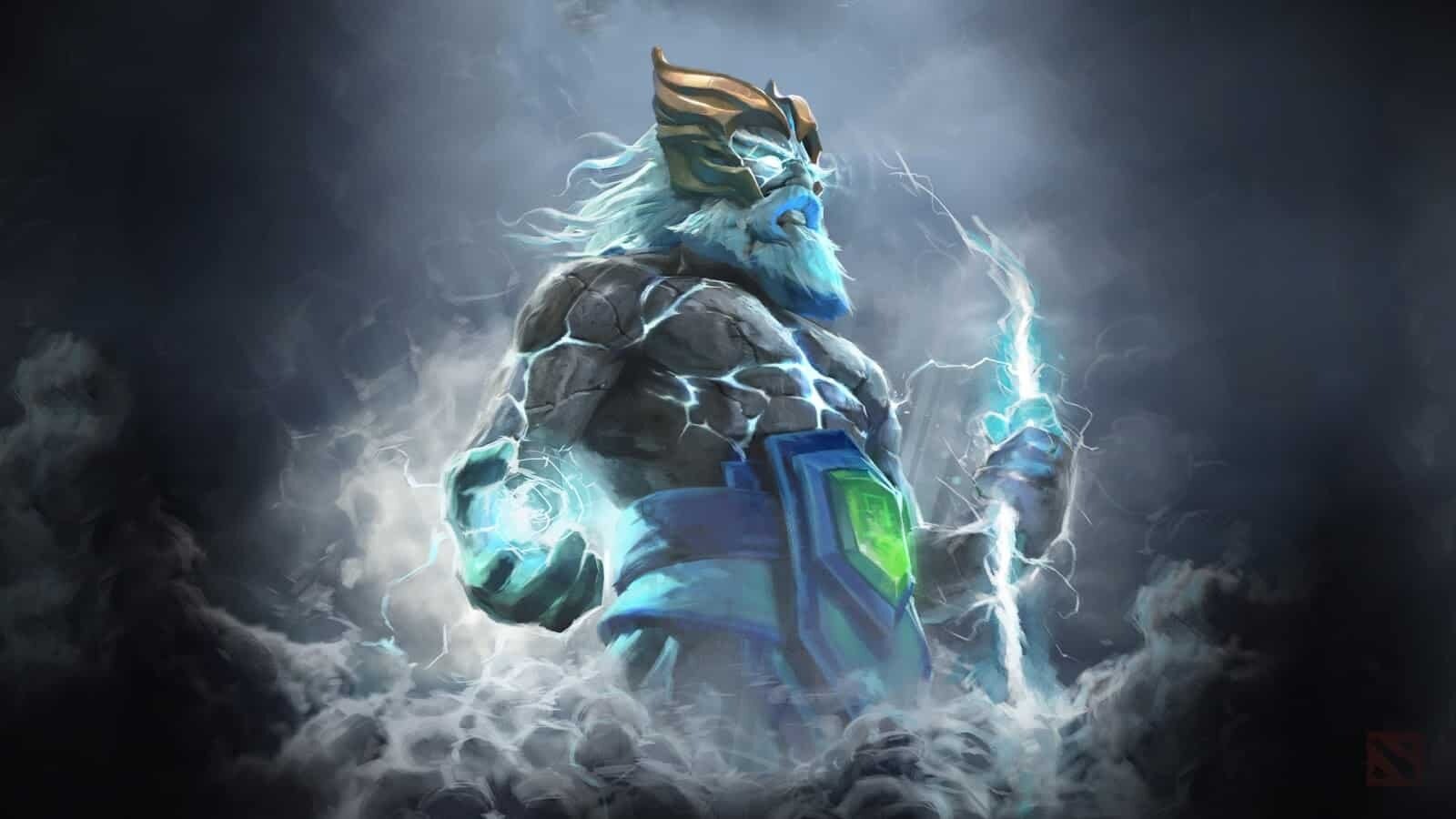
Zeus is an iconic Dota 2 Mid hero, and one that's reasonably easy to learn
What Are the Basics of Playing Mid in Dota 2?
As mentioned in the introduction, the solo mid role is a purely one-on-one affair. Two players from the Radiant and Dire proceed down the middle lane, sharing the lane with nobody else on their respective teams. This means that help will not be within reach for the most part, making the matchup nerve-wracking for some.
The solo nature of the role does come with a lot of perks, however. The most obvious one is that having no other heroes in the lane means that experience isn’t shared with anyone else. You will get 100 percent of all experience gained this way, whether from creep or hero kills. This of course means that you will gain levels faster, which means that you can be active on the map earlier. The mid lane is, therefore, generally expected to impact a game of Dota 2 in a significant manner.
This isn’t the only way to play mid, though. Some heroes suited to playing mid are more content with farming to get their core items quickly while enjoying the experience advantage. Others are all about pushing the tempo by pressuring their opponents’ mid tier-one tower early. We’ll talk about this some more later in the guide.
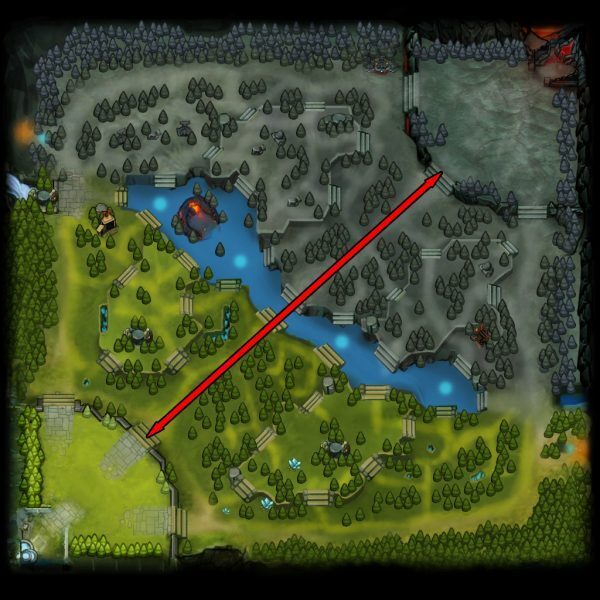
The middle lane is the shortest in terms of total distance and distance between each tower.
As for the physical lane itself, the middle lane is actually the shortest lane in the game. The distance between the two towers and the center of the lane is likewise the shortest in the game. This means that it is very easy for mid laners on either side to run to their respective towers for safety. This contrasts to the side lanes, where the creeps meet up closer to one side’s tower.
What Makes a Dota 2 Mid Hero?
Heroes that are designed to be good as mid laners are often defined by their scaling with levels. That is to say that good mid heroes hit their power spikes in the early to mid game, and scale more with experience gain rather than raw gold. This naturally goes hand in hand with the mid lane’s solo experience gain, which mid heroes definitely enjoy.
Scaling with levels means that mid heroes want as much experience as possible in the shortest amount of time. This allows them to invest skill points in their abilities faster than heroes in the side lanes. These abilities tend to be high damage spells that can facilitate early kills and gank attempts. Examples of such abilities include Puck’s Waning Rift (W), Lina’s Laguna Blade (R), and Queen of Pain’s Sonic Wave (R).
On the other hand, mid heroes that prefer to farm or pressure the mid tower are often equipped with wave-clearing spells. Those like Shadow Fiend with his Shadowraze (Q/W/E) and Death Prophet with her Crypt Swarm (Q) can mow down creep waves in a hurry. Doing so gives them plenty of gold in a short period of time, and it allows friendly creeps to chip away at the enemy tower.
This is in stark contrast to hard carry heroes, which generally scale better with gold than experience. Carries tend to have their power spikes later in the game when they have two or three big, expensive items. Mid laners on the other hand tend to see their power spikes when they hit certain levels. Don’t get us wrong, though — mid lane heroes definitely still enjoy a gold advantage. It’s just that they don’t seek it out as much as carries do.
The Three Types of Dota 2 Mid Heroes
Just like the carry role, there are “sub roles” within the solo mid position. As mentioned in the previous sections, not every mid hero is made the same way — so it’s important to categorize them accordingly.
Tempo Controller
The tempo controller is the purest form of the mid lane hero. They scale very well with levels, and grow more powerful as they gain access to their abilities. Tempo controllers are responsible for putting pressure on the enemy team, typically by rotating to the side lanes and securing early pickoffs. They do this by way of their innate mobility and early damage output, which allows them to ambush enemy heroes and burst them down quickly.
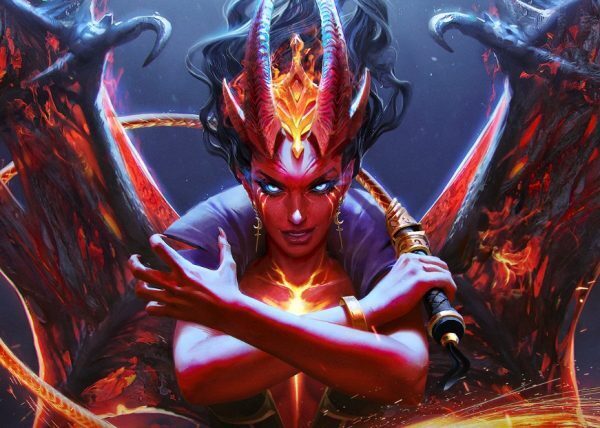
Queen of Pain is a great example of a tempo controller with a high skill cap
By playing this way, tempo controllers force their opponents to react accordingly—lest they lose towers or feed deaths to the tempo controller’s team. To prevent this, the enemy team’s heroes will have to commit precious resources like mana, ability cooldowns, and even their own lives. If they catch their opponents off guard enough, tempo controllers can quickly snowball out of control and prevent the game from even going late.
Tempo controllers can also directly assist the side lanes from time to time. The most classic example of this is when a mid laner rotates to their team’s safe lane. They then gank the opposing offlaner and soft support, which relieves pressure from their team’s carry and allows them to farm more safely. In essence, this makes tempo controllers fall under the “semi-carry” designation, as they are responsible for taking on the carry role before the true hard carry is ready to fight. But despite this, they should not be expected to carry the team in the late game, as they are often designed to fall off in efficacy in longer matches.
The tempo controller has roots that go all the way back to the original DotA custom game in WarCraft III. Back then, mid heroes fell almost exclusively under this category, as this playstyle was the most effective during that time. If you’re into the idea of high-skill cap heroes that can put on flashy and dazzling plays, consider mastering the tempo controller. Examples of such heroes include Void Spirit, Puck, and Queen of Pain.
Solo Farmer
The solo farmer is the tempo controller’s antithesis, despite the fact that they are still distinctly mid heroes. Rather than using their solo experience gain to gank the side lanes, solo farmers leverage their early levels to farm even faster. Heroes under this classification tend to have efficient AoE damage spells, which can clear creep waves and accelerate their farming pace.
These heroes then utilize their aggressive farming styles to become secondary carries. Their scaling is often such that they can play alongside the hard carry to help secure the late game even further—though to a lesser degree. But although they prefer to farm more than gank early on, farming mids can absolutely still take over games before they go late. Shadow Fiend, for example, can roll over entire teams after farming for a bit, some time before the opposing carry can mount a defense.
Other examples of solo farmers include Storm Spirit, Alchemist, and Magnus. Their flash farming capabilities also pressure the opposing mid laner, who will find themselves having to defend the tier one tower from large creep waves.
‘The Big Cheese’ or Gotcha Picks
A few mid heroes in Dota 2 are called “gotcha” picks by the community because these heroes can sometimes win the game outright at the draft screen. These cheesy heroes are often built so that they can secure the win with almost no effort if there are no counters on the other team.
This is often because ofthe nature of their kit and how they can snowball obscenely hard if left unchecked. Heroes like Huskar, Meepo, and Broodmother—whose individual designs necessitate specific picks or strategies to counter them, fall under this category. For example, Huskar’s lane dominance is almost unmatched thanks to Burning Spear (W), and he is incredibly difficult to bring down thanks to his natural durability. Meepo relishes games where he doesn’t have to play against AoE nukes, and so does Broodmother.
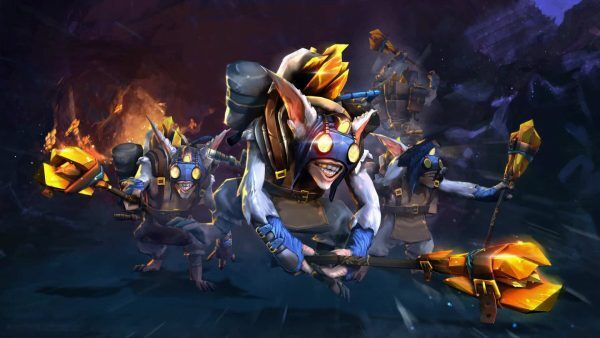
Meepo is perhaps the ultimate cheese pick
Because these heroes are uncommon in public matchmaking, the surprise factor makes it attractive to pick them in the draft’s final phase.. This is of course only possible if the conditions are right, so careful consideration of your draft and that of the opponent is paramount. Cheese picks also tend to require advanced game sense and above-average mechanical skill, so they’re definitely not easy to pick up and play.
How Does the Mid Matchup Normally Go?
In the early days of DotA and Dota 2, the mid lane matchup was all about the one-on-one duel. It basically boiled down to whoever killed their lane opponent first. This was pretty much the sole determining factor for who “won” the lane—but the matchup has evolved and moved away from that since. Nowadays, playing mid is a hybrid between the duels to the death of the past and applying tower pressure and contesting creeps.
Even though the matchup has changed over the years, though, the overarching concept remains the same. You’ll want to make sure that your lane opponent gets the smallest number of creep kills as possible—either by denying them or harassing them out of the lane. You should of course do this while keeping your own creep score up as well.
Mano vs Mano
The exact nature of the head-to-head matchup will depend on your hero and your lane opponent’s hero. Some heroes have worse matchups against certain opponents than others, and knowing how to deal with unfavorable contests comes only with experience. Still, there are things that can be considered standard practice in the mid lane, which apply to most matchups in general.
For example, you can either harass your lane opponent with regular attacks, or spend mana on abilities to achieve the same thing. Whether or not your hero is conducive to either method will depend on their design, kit, and base attributes. Careful consideration of these factors is key to winning the matchup. Naturally, your opponent’s hero choice will also factor in here, so make sure to consider what they can do to you in retaliation.
Rune Control
Then there are the power runes, which spawn in specific spots in the northwest and southeast sides of the river close to the lane. As they are both somewhat within reach from the lane, controlling these runes can swing the matchup in one side’s favor. Some heroes even become extremely lethal when picking up certain runes, which means that effective rune control can outright determine the outcome.
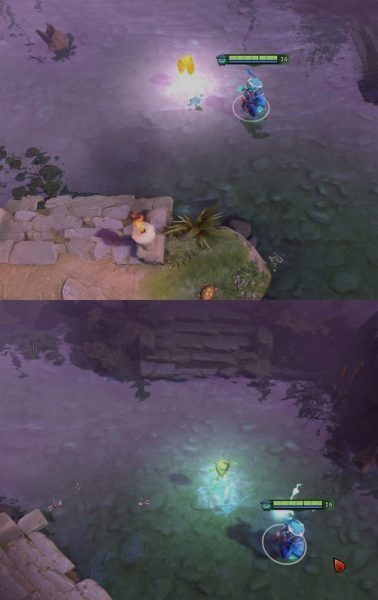
The power runes spawn starting at the 4:00 minute mark, and every two minutes thereafter.
For instance, someone like Templar Assassin, whose main weakness is her pitiful attack range, can go for a kill attempt on her lane opponent if she picks up a haste rune. Queen of Pain likewise becomes deadly if she has a double damage rune, which supplements her high magic burst damage. Used correctly, the runes can and will affect the matchup in a significant manner—so it’s important to keep track of them.
Moreover, the power runes are also sources of health and mana regeneration. Bottle users like Puck and Storm Spirit depend on picking runes up to sustain themselves in the lane. Picking up a rune with a Bottle can also help salvage a bad lane outcome, or speed up the farming pace of a solo farming mid. These all make it clear that controlling the runes is even more vital when your hero uses a Bottle, but note that it’s not worth trading away your life just to pick them up.
If your hero isn’t good at controlling the power runes (such as when they don’t have built-in mobility), there’s also the bounty runes to pick up. They only spawn every five minutes, though, and don’t directly empower your hero when picked up. Certainly better than never getting any Bottle charges, though.
Vision and Creep Blocking
Unlike the sidelines which have equal elevation, the mid lane is different. Each end of the lane is on higher ground than the river which splits it in half. This means that anyone who is in the river itself will not have vision of the opponent’s high ground — which is a huge disadvantage. Maintaining vision of this area is paramount, especially in the first five minutes of the game or so.
To do this, it is imperative to start the matchup with at least an Observer Ward in tow. We highly recommend purchasing one of the available Observer Wards at the start of the game, especially since they’ve been free since Patch 7.23. There are several different spots you can place this ward in — but as a general rule you’ll want vision over the ramp and one of the rune spawns. Having both makes it easier to pull creep aggro when necessary, and to keep tabs on the runes at all times.
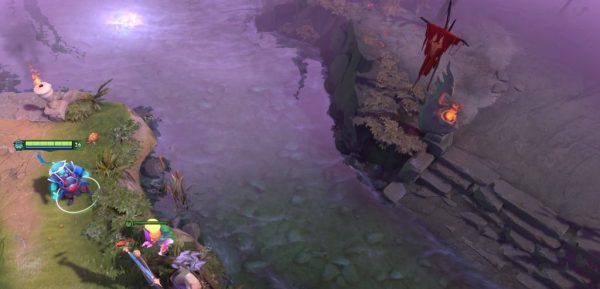
This ward covers the top rune spawn (the wisp of light to the top left) and the high ground on the Dire side.
Naturally, your opponent is likely to do this as well, which makes counter warding also important. One tip we can give regarding this is to check your opponent’s inventory at the start. If he has any wards in his inventory, you’ll know to keep track of when it disappears from his bag. If he doesn’t, and he is able to pull creep aggro from you despite being in the river, it means there’s a ward in the lane somewhere. Go buy yourself a Sentry Ward if so. From there, it’s pretty much a guessing game as to where the ward actually is, which may or may not work in your favor. If it does, then you’ve got yourself some free gold and experience—assuming they don’t deny the ward.
One more crucial skill to learn when it comes to playing mid is creep blocking. Creep blocking is exactly what it says on the tin: you block the incoming creep wave with your hero’s body. This makes the creeps themselves meet more towards your side of the map, giving you a high ground advantage if done correctly. To do this, assign your hero to a control group (Ctrl + 1, for example), then double- tap that control group key to lock your camera to your hero. Then you’ll want to weave left and right in front of the leading creep just enough.
This will force the creeps to stop and go on their way to the river, hopefully causing them to meet the enemy wave on your ramp. Watch the clip above to see exactly how this should unfold.
Tactical Retreat
In some cases, there just isn’t a way to avoid getting crushed in the lane matchup. Since you won’t have anyone to help you for the most part, trying to brute force your way through the contest may end up putting you way behind in levels and creep score. There are two ways to go about solving this, and which one works best for your hero will be determined by the very nature of that hero.
The first and simplest way is to ask for one of your supports to make an early rotation. If their hero is good at this, you can steal momentum in the lane by scoring an unexpected kill on your opponent. The only problem with this is that rotating early can leave your support’s lane partner vulnerable—but again this is dependent on your draft.
The second way is to retreat to the jungle. There are two neutral creep camps that are relatively close to the mid lane—one being an easy camp and the other being a medium camp. If your opponent just hard counters you in the lane (making it impossible to stick around), it’s better to just farm the jungle camps when you can. This will help you stay relevant in the game without you feeding your lane opponent. Whether or not your hero is capable of hitting jungle camps without dying is another story, though, so you may not have much of a choice until you get some more levels. If so, we suggest staying within experience range in the lane at the very least.
For solo farmers, this is generally much easier to do by nature of their wave-clearing abilities. Simply blast the wave down with your spells in order to force your own creep wave to push. This way, your opponent will have to choose between defending their tower, or contesting your safe farm.
Which Dota 2 Mid Heroes Are Best to Start With?
Though the mid lane in Dota 2 is perhaps the most demanding role in terms of mechanical skill, there are some heroes in the position that are pretty straightforward when it comes to execution. These heroes have a very simple game plan, and are quite forgiving in the lane matchup itself.
We recommend the following easy mid heroes to start with:
Zeus
Zeus is perhaps the easiest midlaner of all time, and has very few unfavorable matchups against other heroes. His Arc Lightning (Q) makes it dead simple to score last hits in the lane from a distance without having to risk his own life going up to the creep wave. Meanwhile, his Lightning Bolt (W) also serves as a potent harassment tool, particularly against heroes that don’t have built-in health regeneration.
Once he hits level six, he can make an impact on the game without even leaving the lane thanks to Thundergod’s Wrath (R), which hits all enemy heroes present on the map for a moderate amount of magic damage at once. Later in the game Zeus can put out ridiculous amounts of damage in teamfights, especially with the Nimbus ability from his Aghanim’s Scepter upgrade.
Queen of Pain
Queen of Pain is a lane dominator. Her Shadow Strike (Q) deals heavy magic damage over time to a single target, making it much harder for her lane opponent to play comfortably without risking their life. Her Scream of Pain (E) aids her in flash farming creep waves, while her Blink (W) allows her to either get aggressive or escape gank attempts.
Sonic Wave (R) is one of the most powerful teamfight abilities in the game thanks to its pure damage type. It tears through magic resistance effortlessly, and causes all units in its wake to get knocked back—thus acting as a soft disable.
Dragon Knight
Dragon Knight is a stalwart in the mid lane role thanks to his passive ability Dragon Blood (E). With the bonus armor and health regeneration from Dragon Blood, he is able to shrug off harassment like no other. Thanks to this, he can comfortably sit in the lane, content to take every single creep with his decent base damage and access to a farming spell in Dragon Breath (Q).Thanks to this he is able to comfortably sit in the lane, content to take every single creep with his decent base damage and access to a farming spell in Dragon Breath (Q).
Should his lane opponent choose to leave and gank other lanes, he can apply pressure with Dragon Form (R). This ability transforms him into a fearsome dragon with a ranged attack, that also deals damage over time to towers and other structures. This forces the opposing team to respond, typically by sending one of their heroes to defend the tower. If they don’t, Dragon Knight simply gets a free tower kill.
In the mid to late game, Dragon Knight becomes a fierce semi-carry, especially when Dragon Form is up alongside his potent stun Dragon Tail (W). As one of the longest single-target stuns in the game, Dragon Tail can help pick key targets off quickly—giving Dragon Knight’s team the immediate advantage in teamfights.
P/S: If you are interested in our blog posts and has been looking for ways to improve yourself as a dota 2 player, you can take a fast quiz test to find out more about our coaching lessons here at vikingdota.com.


